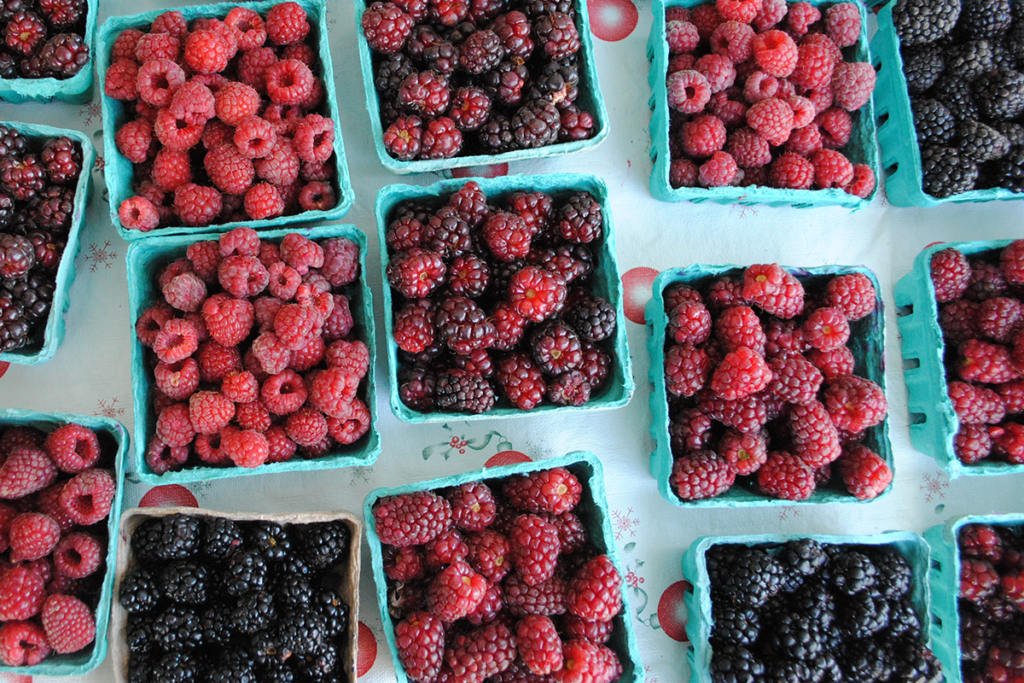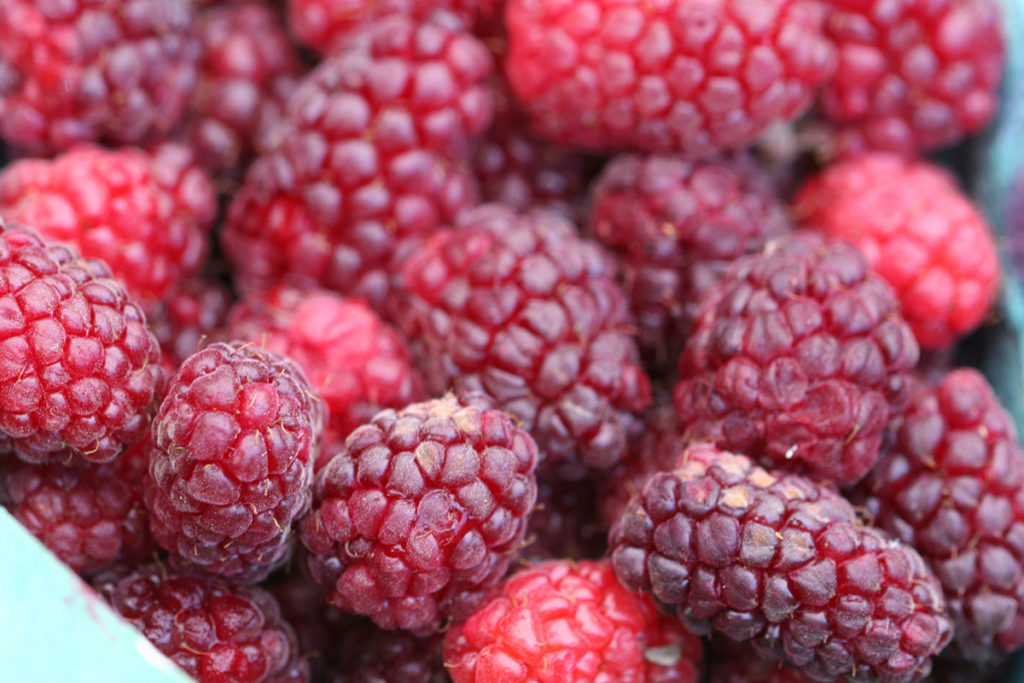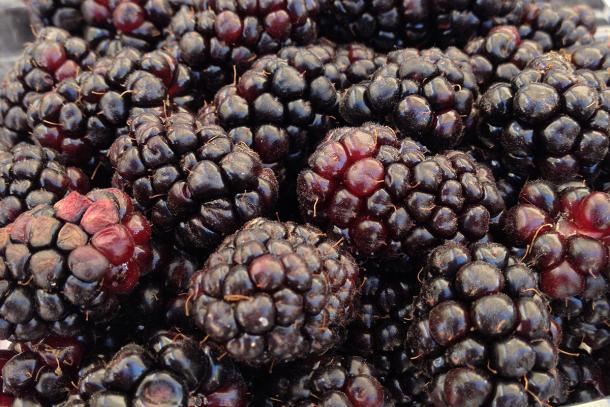Berry Smart: A Farmers Market Guide to Berries
Brie Mazurek, Foodwise Staff
May 25, 2018

What do strawberries, blueberries, and blackberries have in common? Besides having “berry” in the name and making a delicious base for pies and jams, not a whole lot, at least on paper.
Botanically speaking, a berry is a fleshy fruit that contains many seeds and is produced from a single ovary. Blueberries, huckleberries, and cranberries fit the bill, as do persimmons, avocados, and watermelons. Strawberries and blackberries are a whole different story (more on this later).
The various fruits that we commonly refer to as berries are a motley bunch of spring and summer fruit that are sweet, small, delicate, hard to pick, and quick to perish. Many of these fruits are readily available at grocery stores year round, either frozen or imported. But as anyone who has bit into a bland and watery strawberry knows, berries are best enjoyed freshly harvested at their seasonal peak.
For Poli Yerena of Yerena Farms in Watsonville, the Central Coast provides the ideal conditions for growing delicious strawberries, blackberries, and raspberries. “First, it helps to have sandy soil, because the fruit takes the minerals up,” he says. “Second, because we’re close to the ocean, it’s foggy most of the time. It takes longer for the berries to get ripe, which gives them good flavor.”
Here are some locally grown berries you can look forward to as we head into berry season. Due to their short shelf life, many of these berries are rarely found outside of farmers markets and backyard gardens, so savor them in their juicy glory while you can.

Blueberries: Let’s start with the only true berry in the bunch. One of the few fruits native to North America, wild blueberries were originally gathered by Native Americans, and today the U.S. leads the world in blueberry production. Hailed as a superfood high in antioxidants, blueberries have grown in popularity in recent years, but you can only get them fresh and local May through August.

Strawberries: Not a true berry in the scientific sense, the strawberry is a member of the rose family (Rosaceae) and an “accessory fruit”—a fleshy holder for the actual fruits, which are the crunchy seed-like nodules (“achenes”) that dot the surface. Strawberries should be harvested fully ripe, since they don’t ripen after picking. Popular varieties include Albion, Chandler, Éclair, and Seascape. Right now, you can find Albion strawberries at Yerena Farms and other farms, with Seascapes (a popular sweet-tart variety that is great for jam making) coming soon.

Fraises des bois: Also known as Alpine strawberries, these delicate wild berries from France are a rare sight. Popular with chefs, these small, soft, and intensely sweet and aromatic beauties must be harvested with care and packed into clamshells. You won’t find fraises des bois at supermarkets, as they are highly perishable and don’t travel well.

Pineberries: A rarity even in farmers markets, pineberries are strawberries that are ivory white when ripe and studded with red achenes. They have soft, easily bruised flesh and a tropical, pineapple-like flavor. Do not mistake them for green strawberries, which are red strawberries that are harvested when immature and often used in pickling. This year Poli Yerena started offering pineberries at the farmers market in extremely limited quantities.

Raspberries: Known as cane berries or bramble berries, raspberries, blackberries, and their ilk are also relatives of the rose. They grow on thorny stalks, though many modern cultivars have been bred to be thornless. Raspberries are actually aggregate fruit, meaning they are clusters of “drupelets,” or tiny stone fruit (hence the tiny seeds), not botanical berries. Most commonly red, raspberries can be found in a range of hues, from gold to purplish black.

Blackberries: Larger and juicier than raspberries, blackberries are a sweet-tart treat for out-of-hand snacking as well as preserve making. While raspberries are hollow on the inside after being harvested, blackberries retain the little cone-like stem (“torus”) when picked. Blackberries are nutritional powerhouses, high in anthocynanins and fiber. In addition to getting them at the farmers market starting in late spring, you can also find them growing wild all around the Bay Area in mid to late summer. Forage away, but watch out for thorns!

Loganberries: The loganberry was developed by judge and horticulturist Francis Logan in Santa Cruz in the 1880s, after a blackberry plant and red raspberry plant accidentally crossed in his garden. Juicy like a blackberry, the loganberry is a parent of many other hybrids, like the boysenberry, tayberry, and olallieberry. Find loganberries at McGinnis Ranch later this summer.

Boysenberry: A cross between a raspberry, blackberry, loganberry, and dewberry (a naturally occurring species), the boysenberry was developed by horticulturist Rudolph Boysen the in the 1920s in Napa, and later popularized by farmer Walter Knott, of Knott’s Berry Farm fame. This deep-purple berry is juicy and sweet-tart like a blackberry.

Tayberry: Another hybrid, the tayberry is sweeter and larger than the raspberry, and is generally only available at farmers markets, due to its fragility. Because the plants have thorns, they are also tricky to pick. Farmer Poli Yerena describes them as a blackberry with raspberry flavor. Tayberry season is just beginning at the farmers market and extends through summer.

Olallieberries: If your head is swimming with bramble berry crosses by now, here’s one more delicious one to remember. Perfect for jams and pies, the olallieberry is a cross between a loganberry and a youngberry (blackberry-dewberry cross). Look for olallies at Swanton Berry Farm in June and July.

Mulberry: Though they resemble elongated blackberries, mulberries belong to the same botanical family as figs and grow on trees, not on canes. These intensely flavored deep purple-red berries are difficult to pick and are only harvested when perfectly ripe. They can also be fermented to make wine. You’ll have to wait until July to find mulberries at the farmers market.
Click on the links above for specific berry growers at Foodwise’s farmers market.
